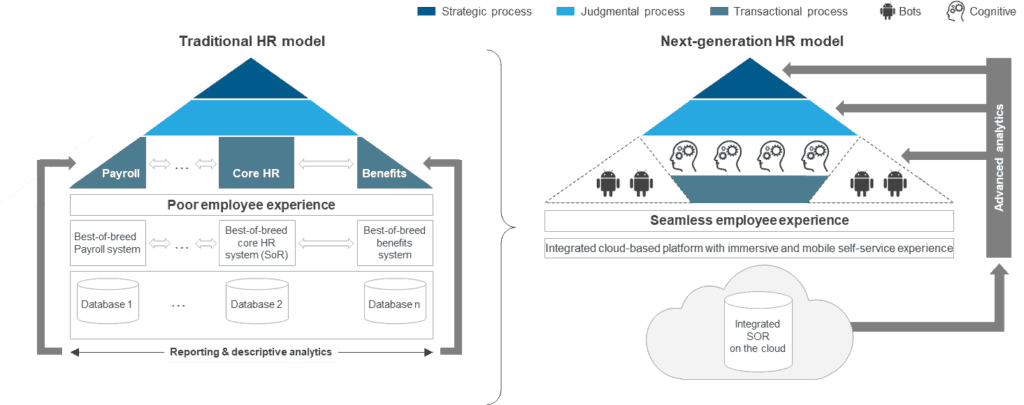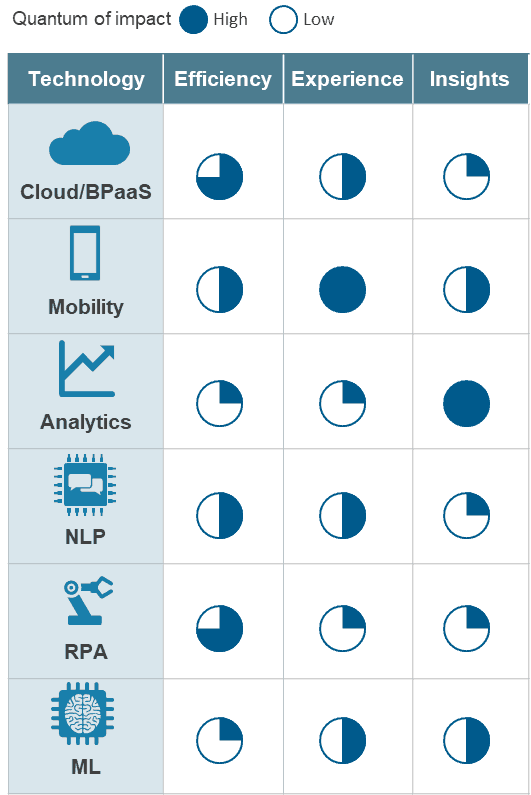Blog
Next-generation HR: Key Considerations for Successful Adoption | Sherpas in Blue Shirts

HR has certainly come a long way in being perceived as a strategic function with significant impact on business outcome. Yet, despite workforce and technology investments, multiple challenges – including the growing talent deficit, problems with skilling and retaining niche talent, and the increasing flexibility and better experience demands of Millennials and Generation Z – are inhibiting HR departments from attaining their full strategic potential on behalf of the enterprises they serve.
The solution is moving to a next-generation HR model with digital transformation at the core.
The inefficiencies of the traditional model – siloed HR systems, a large number of touchpoints, and a disjointed employee experience – are clearly exposed by the challenges cited above. The next-generation HR model addresses these issues with a cloud-based platform at the center, augmented by technologies such as advanced analytics and automation. This results in an intuitive and integrated model that has the ability to provide an enhanced employee experience.
To successfully adopt the next-generation HR model, enterprises should take a structured approach that considers several important factors.
Employee Experience Should be the Focal Point
While the importance of operational cost reduction and process standardization can’t be disparaged, enterprises should prioritize the employee experience when they plan for a digital HR transformation. Be it HR service delivery or technology modernization, the end goal should be to provide an integrated, intuitive, and seamless employee experience to better attract, engage, and retain talent.
In our recently published report, “The Key Ingredients for a Digital-First HR Transformation,” we identified two critical components of the best employee experience:
Empowerment: HR should offer employees integrated, accessible, and disintermediated workflows and systems that empower them to serve themselves. Methods include employee self-service tools, omnichannel experiences, chatbots, and analytical tools, all of which enable employees to have more control over the decisions they make.
Engagement: Millennials and subsequent generations exhibit different behavioral patterns, are digital natives, and expect seamless employee experiences. Enterprises should adopt solutions that enable HR to engage and retain this ever-evolving talent. Solutions that are integrated, user-friendly, and provide consistent experiences across sub-processes / third-party portals with optimized response times and accuracy should be the key focus areas.
Ensure Orchestration of Digital Technologies to Maximize Impact
Rather than implementing a handful of technologies haphazardly, enterprises must take an orchestrated approach to digital HR transformation that enables the technologies to feed off each other, find synergies, and maximize the impact.
The findings in our recently published report made it clear that while each individual technology lever (see chart below) is powerful, enterprises can realize the maximum transformative impact when all the levers are applied in cohesion.
Why is this? Although the impact of technologies such as Robotics Process Automation (RPA) and BPaaS are focused on enhancing the efficiency of various processes, predictive and prescriptive analytics are capable of deriving net new insights.
On the other hand, cognitive/AI technologies such as Natural Language Processing (NLP) and Machine Learning (ML) can be bundled with other digital levers to significantly improve the stakeholders’ experience, in addition to increasing efficiency and providing net new gains.
Engage Service Providers for Help
To help support buyers’ growing demands and needs, service providers are increasingly offering HR and technology consulting services. Capabilities they offer include:
- How to understand and plan for the impact of digital adoption on the enterprise’s workforce
- How to adopt and derive value out of digital investments (i.e., third-party cloud solutions such as Workday, SuccessFactors, and ServiceNow, automation, and analytics solutions)
- How to optimize HR processes
With technology changing so rapidly, organizations need to make sure that they fully embrace digital transformation, and buckle up to face and be ready for the changes. Many organizations are already working in this direction.
To learn more about this topic, our recent report titled “The Key Ingredients for a Digital-First HR Transformation” identifies and deep dives into five key levers (automation, analytics, cloud, advisory, and employee experience) that will help enterprises successfully transform their HR function.
Is your enterprise planning to undergo a digital HR transformation? Have you completed it? We’d love to hear from you about your experiences, questions, and concerns. Please write to us at: [email protected] or [email protected]

